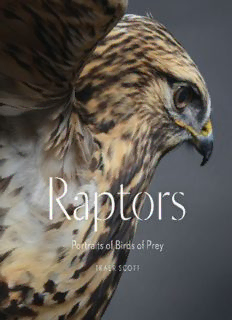
Raptors: Portraits of Birds of Prey PDF
Preview Raptors: Portraits of Birds of Prey
for AGATHA Published by Princeton Architectural Press A McEvoy Group company 37 East 7th Street, New York, NY 10003 202 Warren Street, Hudson, NY 12534 Visit our website at www.papress.com. © 2017 Traer Scott All rights reserved No part of this book may be used or reproduced in any manner without written permission from the publisher, except in the context of reviews. Every reasonable attempt has been made to identify owners of copyright. Errors or omissions will be corrected in subsequent editions. Editor: Sara Stemen Designer: Mia Johnson Special thanks to: Janet Behning, Nolan Boomer, Nicola Brower, Abby Bussel, Erin Cain, Tom Cho, Barbara Darko, Benjamin English, Jenny Florence, Jan Cigliano Hartman, Susan Hershberg, Lia Hunt, Valerie Kamen, Simone Kaplan- Senchak, Jennifer Lippert, Kristy Maier, Sara McKay, Eliana Miller, Wes Seeley, Rob Shaeffer, Paul Wagner, and Joseph Weston of Princeton Architectural Press —Kevin C. Lippert, publisher Library of Congress Cataloging-in-Publication Data Name: Scott, Traer. Title: Raptors : portraits of birds of prey / Traer Scott. Other titles: Portraits of birds of prey Description: New York : Princeton Architectural Press, [2017] Identifiers: LCCN 2016059210 | ISBN 9781616895570 ISBN 9781616896836 (epub, mobi) Subjects: LCSH: Birds of prey—Pictorial works. | Photography of birds. | Wildlife photography. Classification: LCC QL677.78 .S36 2017 | DDC 598.9022/2—dc23 LC record available at https://lccn.loc.gov/2016059210 Contents Introduction GOLDEN EAGLE BARN OWL APLOMADO FALCON BALD EAGLE SWAINSON’S HAWK GREAT HORNED OWL HARRIS’S HAWK CRESTED CARACARA NORTHERN SAW-WHET OWL NORTHERN GOSHAWK EURASIAN EAGLE-OWL BLACK VULTURE BARRED OWL KING VULTURE BROAD-WINGED HAWK PEREGRINE FALCON RED-TAILED HAWK GREAT GRAY OWL KESTREL LESSER YELLOW-HEADED VULTURE ROUGH-LEGGED HAWK EASTERN SCREECH-OWL SAKER FALCON SHORT-EARED OWL SNOWY OWL TURKEY VULTURE SPECTACLED OWL MISSISSIPPI KITE Acknowledgments About the Author Introduction When I was young, one of the four bedrooms in our house was simply known as “the spare room.” In this superfluous room, there was an ironing board; a flimsy work desk where my father kept scraps of ivory and etching tools for scrimshaw; random boxes filled with the detritus of family life: books, papers, costumes, and photographs that had no other home; and numerous animal cages. The animals had usually come home with my mother from the museum where she was a volunteer. That small natural-science museum had a lot of dioramas displaying a menagerie of dead things and a live-animal education center where schoolchildren came to see and sometimes touch indigenous reptiles and insects, along with some exotic specimens like hissing cockroaches and pythons. From time to time, people brought the museum injured or orphaned wildlife, and my family functioned as amateur rehabilitators, nursing these animals back to health. This was often done with limited knowledge, usually consisting of facts and suggestions that the local library and a few native wildlife experts offered up. Of all of the animals that shared the rather dull, suburban experience of life in the spare room, the one that I remember the most was a tiny screech-owl who lived with us for several months. I believe that this tiny owl had flown into someone’s sliding glass door, of which there were a great many in North Carolina. The panoramic reflections in these giant sheets of glass (like those in any window) confuse birds and cause many millions of avian deaths every year. This owl had been stunned and suffered an injured wing. Only about seven inches tall, the little owl that we categorically named “Screech” lived in a small wire cage in the spare room, where she perched and slept and clicked her beak when she wanted something. We fed her live, unconscious mice, which she swallowed whole, usually pausing with the poor creature’s tail hanging out of the side of her mouth like a postmeal cigarette. Her beautiful feathered eyelids silently opened and closed over huge, unmoving eyeballs while her head swiveled impossibly far around her tiny neck. I remember being struck by how something so small could be so powerful. Her downy feet were disproportionately huge, with talons that looked as if they had been filed to razor-sharp points. They gripped the perch with primordial authority and seemed to belong to a much larger, more dangerous animal. There was something almost prehistoric about her: a quiet but majestic might that our domestic pets lacked. As an animal photographer, I have since discovered that this intensity is present in many forms of wildlife. I think it is what fascinates us about wild animals—this feral wisdom and extreme ability that are encoded in them. It is a
Description: